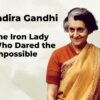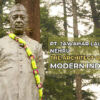In a world ruled by men, in a country finding its footing after freedom, she rose not as someone’s daughter or someone’s wife, but as a force in her own right.
She wasn’t soft-spoken.
She wasn’t apologetic.
She was fierce, flawed, and fearless.
Indira Gandhi, India’s first and only woman Prime Minister, walked through fire — and led India through war, famine, crisis, and change.
They called her many names: autocrat, daughter of Nehru, dictator, Durga but above all, she was a leader who dared to do what no one else could.
The Making of a Fighter
Born on 19th November 1917, in Allahabad, Indira was the daughter of Jawaharlal Nehru, India’s first Prime Minister.
But her childhood wasn’t filled with toys — it was filled with prison visits, protests, and political debates.
Her family sacrificed everything for freedom — and young Indira, watching from behind the shadows, was quietly learning.
She founded the “Vanar Sena”, a group of children who carried messages and flags during the freedom struggle. Even as a child, resistance ran in her blood.
She studied at Oxford, traveled across the world, and absorbed the art of leadership and survival.
From Daughter to Decision-Maker
When Nehru passed away in 1964, the Congress party was looking for a successor.
Indira was chosen — not because they thought she was powerful, but because they thought she could be controlled.
They were wrong.
In 1966, Indira Gandhi became the Prime Minister of India — the first woman to lead the world’s largest democracy.
She began quietly. Observing. Listening. But soon, she revealed the strength within.
“Forgiveness is a virtue of the brave.” – Indira Gandhi
The Woman Who Would Not Bow
Indira Gandhi faced war, food shortages, internal rebellion, poverty, and global pressure. But she faced them head-on, like a warrior queen with her spine of steel.
🇵🇰 The 1971 War & Bangladesh
When millions of refugees from East Pakistan (now Bangladesh) poured into India, Indira didn’t blink.
She prepared India for war. Under her leadership:
- India decisively won the 1971 war against Pakistan
- Over 90,000 Pakistani soldiers surrendered
- A new nation — Bangladesh — was born World leaders watched in shock.
And an Indian poet declared:
“Indira is not a woman, she is Durga.”
Bold Reforms, Bold Risks
Indira believed in self-reliance and socialism. She introduced:
- The nationalization of banks
- The abolition of privy purses (royal privileges)
- The Green Revolution – boosting India’s food production
- A strong foreign policy of non-alignment
She walked with kings and communists, presidents and peasants — with the same confidence.
But power has a price.
The Emergency: Her Darkest Hour
In 1975, after a court ruling questioned her election, Indira declared a state of Emergency across India — suspending civil liberties, jailing opposition, and silencing the press.
This became the most controversial chapter of her rule. Some called it necessary. Others called it dictatorship.
But even her harshest critics could not deny — she was the most decisive leader India had seen.
In 1977, she lost the election.
But in 1980 — she returned to power, stronger than ever. The people still believed in her.
Assassination & Immortality
The 1980s brought new challenges — especially the rise of Khalistani separatism in Punjab.
Indira ordered Operation Blue Star in 1984 to flush militants out of the Golden Temple. It was a decision that would cost her life.
On 31st October 1984, Indira Gandhi was assassinated by her own bodyguards, just months after she said:
“If I die today, every drop of my blood will strengthen this nation.”
And it did.
Her death led to mourning, riots, and a deep scar — but also a legacy of courage that never faded.
Legacy: The Woman Who Ruled with Fire
Indira Gandhi was not perfect. She was complex, controversial, courageous. But she changed India’s destiny — not with apologies, but with action.
She proved that a woman could lead in a man’s world, and not just survive — but command, create, and conquer.
Her statues stand tall.
Her decisions still echo in Parliament.
And her life continues to inspire girls who dream, and leaders who dare.
Conclusion
Indira Gandhi taught India that leadership isn’t about gender — it’s about guts.
She taught us that it’s okay to be feared and respected, as long as you’re fighting for your people.
She didn’t chase popularity. She chased progress.
And in doing so, she became India’s Iron Lady — unbreakable, unforgettable, unstoppable.








